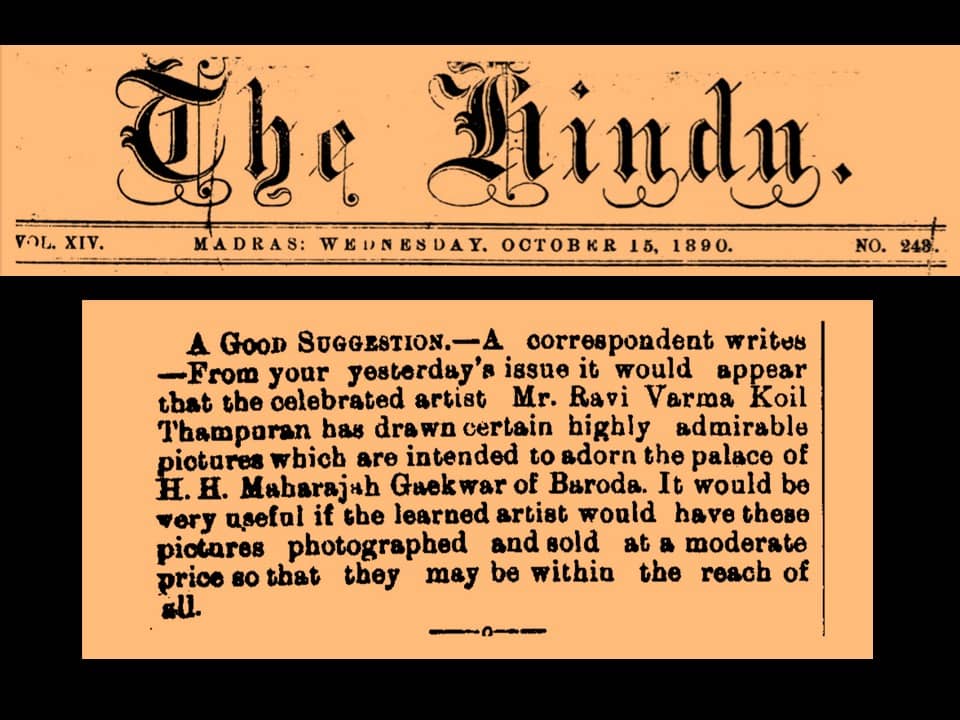
0
Surrendering is not a passive act.
It is a choice.
The ultimate agency before losing.
But what if losing made you come alive?
Scroll down and experience what it means to surrender
IN COLLABORATION WITH





In particular, his depictions of Hindu deities and episodes from the epics and Puranas have received profound acceptance from the public and are found, often as objects of worship, across the length and breadth of India.


Ravi Varma's works are a fusion of European techniques with a purely Indian sensibility.
His lithographs increased the involvement of common people with fine arts and defined artistic tastes among common people for several decades.


Photograph of Ravi Varma









THE CULT(URAL) LEGACY







The Tamil Lady playing the Swarbat by Raja Ravi Varma, originally painted in 1874, was exhibited at the Madras Fine Art Society Exhibition and was gifted, thereafter, by the Maharaja of Travancore to the Prince of Wales (Later King Edward VII) during this trip to India in 1875. This work is the earliest recorded painting which has a later version by the artist. It is this demand for copies which would eventually lead to the establishment of a Press in his name.
A Tamil Lady Playing the Swarbat
Raja Ravi Varma










Sir T. Madhava Rao
By Raja Ravi Varma


Ravi Varma found a mentor and a trusted advisor in Dewan Madhava Row. He recommended Ravi Varma to the British administration, introduced him to his greatest patron, Maharaja Sayaji Rao Gaekwad II and also had Ravi Varma send some of his paintings to Europe to have them oleographed. He prophesied how it would extend Varma's reputation and that he would also be doing a great service to the country.






Representing India at the Chicago Exposition of 1893 were two prominent Indians: Swami Vivekananda and Raja Ravi Varma.
While he was not allowed to travel over the 'dark waters', he sent ten paintings of which, 'There comes Papa' was one. Modelling for this painting was his own daughter, the stunningly beautiful Mahaprabha.



There Comes Papa
Painting by Raja Ravi Varma


The Chicago Exposition, 1893

The Other Works at
the Exposition











Birth of Shakuntala marked the first chromolithograph printed at the Ravi Varma Fine Art Lithograph Press, Bombay.
Commencing on July 12, 1894, the Ravi Varma press took on a life of its own, resolute in altering the social, religious and aesthetic notions of the common man.








Birth of Shakuntala
The first lithograph of Raja Ravi Varma


The Printing Press

Ravi Varma's other works
of Shakuntala's Story






In September, 1894, the chromolithographs of Goddesses Lakshmi and Saraswati were launched, revolutionary for their time. Back then, access to religious methods and places of worship were severely restricted to certain classes of society. The process of opening temples to the masses commenced only in the 1930's and was substantially set in motion by the Temple Entry Proclamation of Travancore in 1936.
The Lakshmi and Saraswati chromolithographs breached every religious injunction and restriction by making their way into every Hindu home offering across all classes and castes access to religious imagery.
Saraswati
The lithograph and the lithostone






The images from the Ravi Varma Press were extensively used for advertising. The objective of the advertiser was essentially to refresh the memory of the brand in the mind of the customer. The printed calendar was most suited for this purpose as it ensured the image and the message of the advertiser would be viewed on a daily basis.















Calendar Art
&
Art Beyond Borders

Ravi Varma's works
On Matchlabels
Menaka & vishwamitra
in Japanese Advertisements















ABUSED GODDESS CAMPAIGN
(Courtesy: Taproot)
The online campaign (released in 2010) entitled Abused Goddesses, depicted Hindu goddesses Lakshmi, Saraswati and Durga in the style of classic calendar art, but as victims of domestic abuse with graphic bruises and black eyes. Drawing inspiration from Ravi Varma's style of calendar art, this campaign designed by Taproot agency drew the reader’s attention toward the fact that although goddesses are revered in much of Indian culture, instances of domestic violence against women in India is staggeringly high.










Kadambari
A Tale Through the Ages

Kadambari was the last picture Raja Ravi Varma painted before his demise in 1906. His works continue to live on in an Instagram series by artist Rahul V Mathew who recreates Raja Ravi Varma’s mythological subjects with provocative and witty tweaks. Seen here is Kadambari solo jamming in a parallel universe framed by Mumbai’s Marine Drive (as the couple continues to be consumed by technology).



